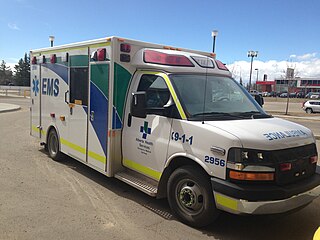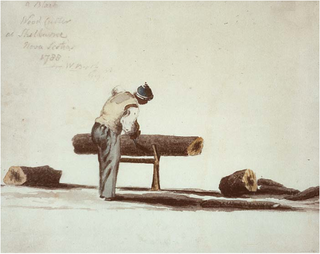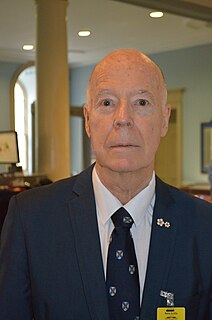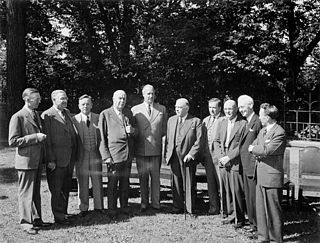Daurene Elaine Lewis,, was a Canadian politician and educator. She was the first black female mayor in Canada.

Digby is a town in southwestern Nova Scotia, Canada. It is the administrative centre and largest population centre in Digby County. The town is situated on the western shore of the Annapolis Basin near the entrance to the Digby Gut, which connects the basin to the Bay of Fundy.

Spryfield is an unincorporated suburban community in Halifax, Nova Scotia, Canada. It was founded about 1770, by Captain William Spry, who purchased land there and established the settlement with the aid of stationed soldiers from the nearby Halifax garrison. In 1783, he sold the property and returned to England. The name "Spryfield" is also sometimes used to refer to the general area of Halifax's South Mainland, which includes a number of communities along the Herring Cove and Purcell's Cove Roads.

A paramedic is a healthcare professional, providing pre-hospital assessment and medical care to people with acute illnesses or injuries. In Canada, the title paramedic generally refers to those who work on land ambulances or air ambulances providing paramedic services. Paramedics are increasingly being utilized in emergency rooms by providing patient care in collaboration with physicians, physician assistants, nurse practitioners, registered nurses, registered/licensed practical nurses and registered respiratory therapists. Increasingly in Canada, paramedics are actively pursuing self-regulation.

The IWK Health Centre is a major paediatric hospital and trauma centre in Halifax, Nova Scotia that provides care to maritime youth, children and women from Nova Scotia, New Brunswick and Prince Edward Island. The IWK is the largest facility in Atlantic Canada caring for patients under 20 years of age.

Middle Musquodoboit is a farming community in the Musquodoboit Valley region of the Halifax Regional Municipality, along the Musquodoboit River at the junction of Route 357 with Route 224, 78 kilometres (48 mi) from Dartmouth, Nova Scotia. The community's name comes from the First Nations' word Mooskoduboogwek, which means to suddenly widen out after a narrow entrance at a mouth. For a time after 1883, Middle Musquodoboit was called Laytonville, but at some point reverted to its former name.

Emergency Health Services (EHS), a Canadian emergency medical services (EMS) agency, is responsible for providing emergency and primary health care to patients outside of a hospital. It also deals with transportation between hospitals and medical facilities.

Duncan Cameron Fraser was a Canadian lawyer, politician, judge, and the ninth Lieutenant Governor of Nova Scotia.

Black Nova Scotians or African Nova Scotians are Black Canadians whose ancestors primarily date back to the Colonial United States as slaves or freemen, and later arrived in Nova Scotia, Canada during the 18th and early 19th centuries. As of the 2016 Census of Canada, 21,915 black people live in Nova Scotia, most in Halifax. Since the 1950s, numerous Black Nova Scotians have migrated to Toronto, Ontario, for its larger range of opportunities. Before the immigration reforms of the 1960s, Black Nova Scotians formed 37% of the total Black Canadian population.
David G. Coles, is a Canadian lawyer. He received his B.A. from Dalhousie University in 1981. He then received his LL.B. in 1984, also from Dalhousie. He was admitted to the Nova Scotia Bar in 1985.
The Capital District Health Authority was the largest of the nine health authorities in the Canadian province of Nova Scotia. In 2015 it was merged into the new, province-wide Nova Scotia Health Authority.
The word "nurse" originally came from the Latin word "nutrire", meaning to suckle, referring to a wet-nurse; only in the late 16th century did it attain its modern meaning of a person who cares for the infirm.

Eastern Shore Memorial Hospital (ESMH) is a hospital in Sheet Harbour, Nova Scotia. It is operated by Nova Scotia Health Authority.

The Nova Scotia Paramedic Society (NSPS) is a professional association established in 2011 that promotes the study, research, and communication of the history of Emergency Health Services (EHS) within the province of Nova Scotia, Canada.

The Ambulance Operators Association of Nova Scotia (AOANS) was the provincial association representing ambulance company owners in Nova Scotia. The association's focus was negotiating with the Government of Nova Scotia over funding and private ownership of ambulance services. The AOANS was also contracted by the Government of Nova Scotia to provide a training program for ambulance personnel and an ambulance inspection program. Between 1994 and 1999, after the publication of the Murphy Report, Nova Scotia transitioned to a single ambulance service provider. This resulted in the AOANS members being bought–out and their ambulance services merged into the new system. The AOANS was formally dissolved in 2002.

Ronald Daniel Stewart is a Canadian politician. He represented the electoral district of Cape Breton North in the Nova Scotia House of Assembly from 1993 to 1997. He was a member of the Nova Scotia Liberal Party.

The Local Council of Women of Halifax (LCWH) is an organization in Halifax, Nova Scotia devoted to improving the lives of women and children. One of the most significant achievements of the LCWH was its 24-year struggle for women's right to vote (1894-1918). The core of the well trained and progressive leadership was five women: Anna Leonowens, Edith Archibald, Eliza Ritchie, Agnes Dennis and May Sexton. Halifax business man George Henry Wright left his home in his will to the LCWH, which the organization received after he died in the Titanic (1912). Educator Alexander McKay also was a significant supporter of the Council.
Sibella Annie Barrington was a Canadian nurse.
All ground ambulance, medical communications, air ambulance service in Nova Scotia, Canada, is contracted by EHS to Emergency Medical Care Inc. (EMC), a subsidiary of Medavie Health Services.
















